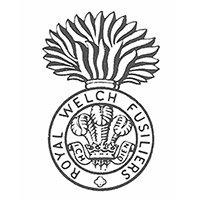
Horace Walter Bradley

Inns of Court Officer Training Corps (OTC)
then
1/4th Battalion, London Regiment
Sub-Lieutenant 5467
 | Horace Walter Bradley |  |
| Royal Welch Fusiliers Inns of Court Officer Training Corps (OTC) then 1/4th Battalion, London Regiment Sub-Lieutenant 5467 | ||
| Killed in action: 10th February 1917 |
Horace Bradley's Parents | ||
|
Horace Walter Bradley was the eldest of three children born to Thomas Walter Bradley and his wife Emma Ellen (nee Hayes). Thomas was born in Oxford and Emma was from Clutton, but in the 1891 census, both had found their way to Bath; Emma was a live-in housemaid – one of a staff of three – to a widower at number 1 Cavendish Crescent and Thomas was a 'fireman' on the railway (stoking fires, of course, not extinguishing them!), boarding at 6, West Avenue. Horace's mother Ellen was a sister of Leonard Hayes' father, making Horace and Leonard cousins. | ||
The Bradley Family |
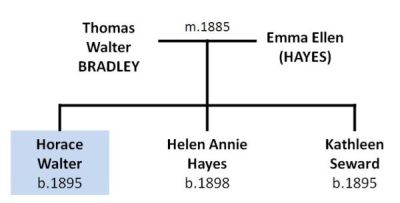 |
|
After marrying at St Michael in Twerton in 1893, Thomas & Emma first lived in Dorset Street, East Twerton, where Horace was born in 1895. Horace was named after his father’s next-eldest brother and also took his father’s middle name. He was baptised in the ‘Moorfields Mission Hall’ in Maybrick Road. The Mission Hall was an ‘iron church’ of corrugated sheet metal and stood at the junction of Maybrick Road and Belvoir Road, a site occupied today by three relatively modern houses. It was an outpost of the church of St Peter on the Lower Bristol Road; St Peter itself was built as part of the parish of St Michael, Twerton, to serve the eastern end of the parish as it grew rapidly in the direction of the boundary with Bath. The Mission Hall was built to serve the district's expansion southwards. |
|
The family moved to 39 South Avenue circa 1898 and then to Claude Avenue in 1900 (when Horace was about 5 years old), living initially at number 42 and then at number 38. It is from these two addresses in Claude Avenue that Horace would have made the extremely short walk to school at South Twerton for the five years that he attended the school. |
|
Claude
Avenue where the Bradley family lived at number 42 (extreme left) and
then number 38; both are within sight of the school! |
|
Horace’s father Thomas progressed to working as an ‘engine driver’ at around this time. It is well documented that engine drivers enjoyed an extremely high status in this era and the step up from ‘fireman’ was a significant one. On main line duties, a train crew could end up many miles from home at the end of the day and were forced to sup and sleep in railway company hostels and lodgings. Despite the close teamwork on the footplate, drivers and firemen would sit at different tables to eat and hostelries sometimes even had separate bars for drivers. It isn’t clear whether Horace’s father worked on the GWR or the Somerset & Dorset railway; the latter line passed within a few yards of the Bradley home and indeed not far from the school; it is now known as the Linear Park or Sustrans ‘Two Tunnels Greenway’. It’s interesting to think that Horace might have heard the whistle of his father’s train from the schoolroom! Horace’s two sisters Helen Annie Hayes Bradley and Kathleen Seward Bradley arrived in 1897 and 1901 respectively. Helen, named after her paternal grandmother, also bore her mother’s maiden name of ‘Hayes’ as a given name; Kathleen bore her father’s middle name of ‘Seward’; perhaps also an earlier family surname that was preserved in the same way. Kathleen died in 1902, however, before reaching her first birthday. Swindon Around 1905, the family moved to Swindon, home of the Great Western Railway, but Thomas’ employment on the railways did not continue. They lived at 343 Ferndale Road in the north of the town. The 1911 census shows Thomas as a builder and Emma as a draper.
343 Ferndale Road, Swindon After 1917, Swindon directory entries show the household at 225 Ferndale Road, with Thomas now a ‘shopkeeper’; it’s possible that this was a draper’s shop. |
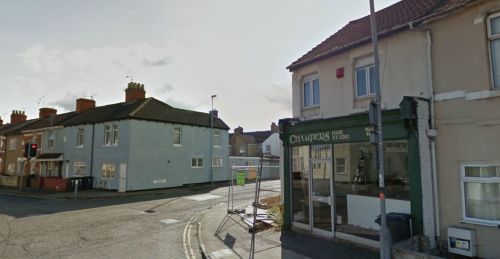 | ||
|
The Bradleys’ shop at 225 Ferndale Road in
Swindon used to be on the corner of Whitehouse Road, beyond “Champers”. Now
demolished. |
|
We know a little of what Horace did between leaving school and the start of the War. In 1911, he was still listed in the census in Swindon as a scholar, aged 15, and we know that he attended the Sanford Street School. The 1920 Bath newspaper report of the unveiling of the South Twerton school memorial includes: Lieut. H. W. Bradley, of the Royal Welsh Fusiliers, was a cousin of Capt. Hayes, and on leaving Bath obtained a position in the laboratory at the Swindon Secondary School. He obtained a high place in a Civil Service Examination, and subsequently held an important appointment in London. |
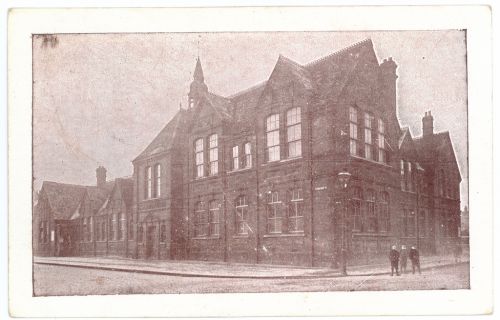 | ||
|
Sanford Street School in Swindon, which Horace attended after the Bradley family's move from Bath [Image: www.swindonhistory.blogspot.co.uk] |
Horace Bradley in WW1 | ||
1914The following announcement in the London Gazette in October 1914 is confirmation of Horace's civil service appointment; he gained a position as an Inspector of the Outdoor Staff with the National Health Insurance Commission. | ||
 |
|
The National Health Insurance Commission came about as the result of Lloyd George's National Health Insurance Act of 1911 and was in many ways the precursor of the National Insurance and National Health Service. |
Royal Welch Fusiliers: Inns of Court OTC
Horace then served with the Inns of Court Officer Training Corps (OTC) Regiment of the Royal Welch Fusiliers (RWF). This unit was known as ‘The Devil’s Own’. The RWF had a tradition of being made up largely of Welshmen and the Inns of Court Regiment usually recruited those with links to the legal profession, but no such links are known for Horace Bradley. He joined on 9th August 1915 and served in 6 and 4 Companies. |
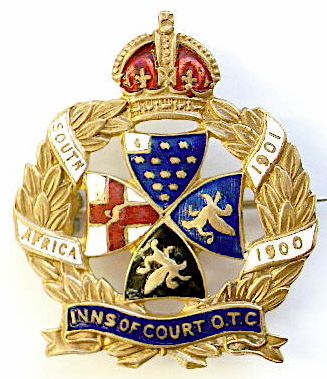 | ||
|
An 'Inns of Court' OTC cap badge and shoulder title (the 'T' denotes a Territorial unit) |
| We don't know much about Horace Bradley's exact movements. In general, we know the following: Until September 1916, OTC trainees were trained and stationed in Berkhamsted in Hertfordshire. The Inns of Court OTC provided basic and officer training at Berkhamsted, where a broad area including farms, fields, woodland and the grounds of country residences was made available for training purposes. This was expanded to include a camp called ‘Kitchener’s Field’ as more capacity was required. The subjects practiced were route marching, map reading, digging trenches, wiring, bombing, musketry, field tactics and strategy which took the form of complete battalion exercises in open warfare. Then there were the usual lectures, which covered a whole range of subjects from leadership, billeting, welfare and trench sanitation. On Berkhamsted Common the remains of around 13 miles of trenches, dug in training exercises, are still visible nearly one hundred years later. |
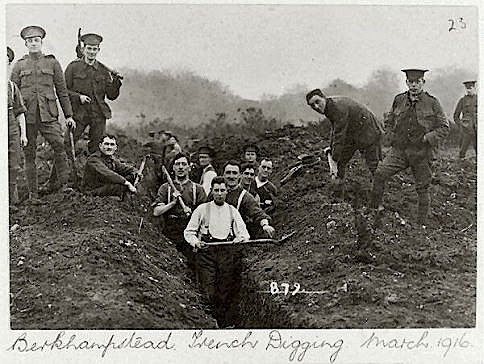 | ||
|
[Image: http://www.chilternsaonb.org/] |
|
2nd Lieutenant A London Gazette notice of June 1916 refers to Horace’s commission as 2nd Lieutenant. |
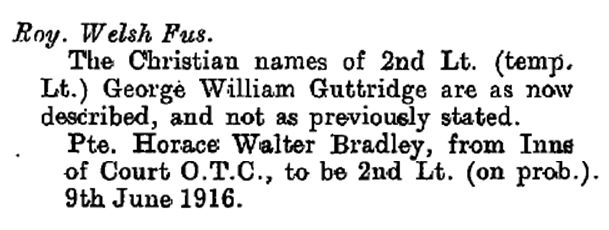 |
|
1/4th Battalion, The London Regiment There is a reference to Horace’s commission leading to service with the 5th Battalion, but he did not serve with the 5th (who were in Palestine); instead his attachment was to the 1/4th Battalion London Regiment (“The Londons”) in France.* * I can no longer find the source for the above! From http://www.1914-1918.net/london.htm: The London Regiment was unusual. Not only were all of its battalions of the Territorial Force (although the first four were affiliated to the other City of London regiment, the all-regular Royal Fusiliers) but each battalion was regarded as a Corps in its own right. The ‘first line’ battalions (originally the 4th, 5th and so on) spun off second line battalions (mainly training units) in late 1914 to early 1915. The original battalion thereby became 1/4th and the new, second line battalion would be the 2/4th; these also saw front line action when trained and ready. So Horace’s posting as 2nd Lieutenant was to active service on the front line in France. |
Horace Bradley's Death | ||
| Records
show that Horace was killed on 10th February 1917 as a victim of
enemy shelling in an area known as ‘The Bluff’. There was no specific battle or
operation in effect in that area on that date; his death is therefore most
likely attributable to the type of intermittent shelling that was a constant
feature of life on the front. | ||
Burial | ||
|
2nd Lieutenant Horace Bradley is buried at St Vaast Post Military Cemetery in Richebourg-l’Avoué, France. From the Commonwealth War Graves Commission: The
village of Richebourg-l'Avoué was held by British forces from the
autumn of 1914 until it was overrun by German units advancing west
during the great Spring Offensive in April 1918. It was recaptured by
Commonwealth soldiers in September 1918 and remained in Allied hands
until the end of the war. The village was less than two kilometres from
the front-lines trenches and was routinely shelled by German artillery. | ||
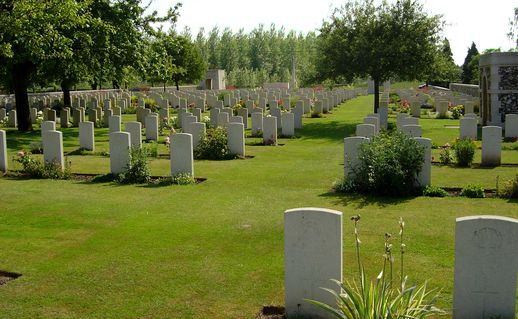 | ||
|
St Vaast Post Cemetery, France |
| Horace Bradley's
grave has been visited by Mike Sumsion, who has made several visits to
the Western Front to the graves of soldiers from Bath. He has kindly
supplied us with this photograph: |
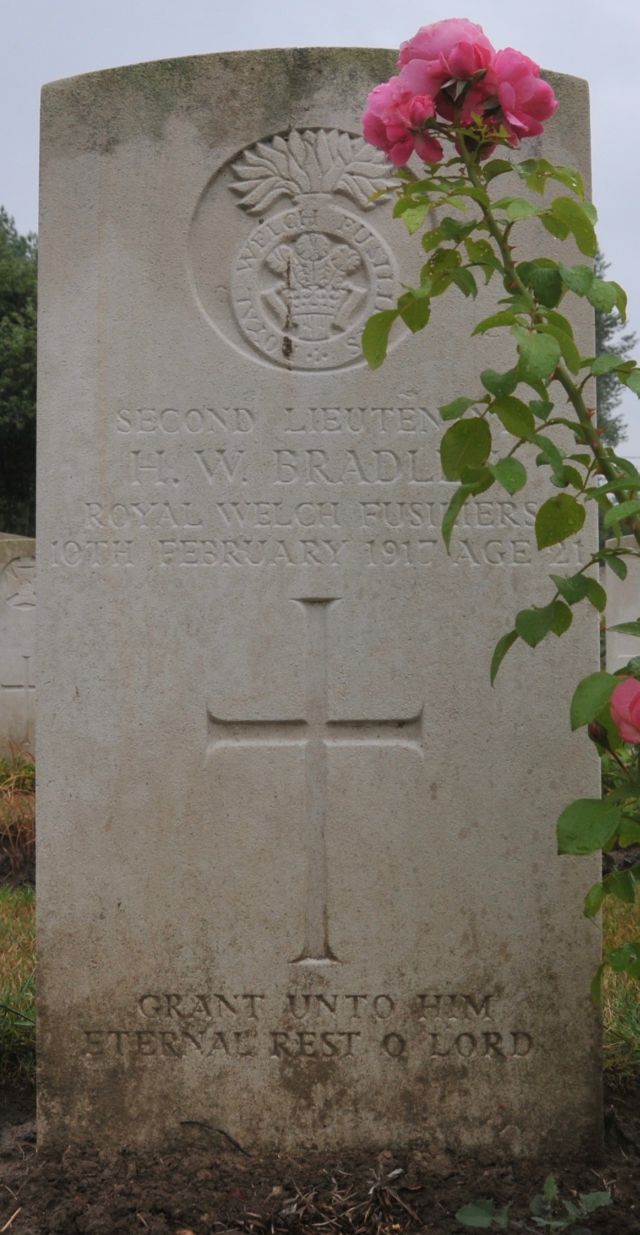 |
Decoration | ||
|
2nd Lieutenant Horace Bradley would have been awarded the British
War Medal and the Allied Victory Medal posthumously. | ||
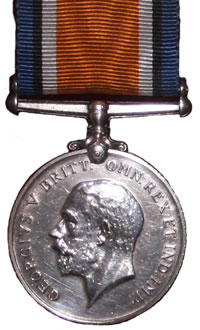 | 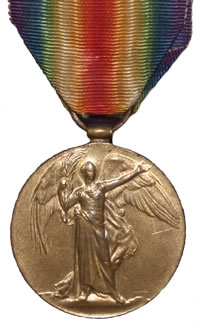 | ||
| British War Medal 1914-18 | Allied Victory Medal |
Commemoration | ||
 In addition to his commemoration on the South Twerton School memorial, Horace Bradley is commemorated as follows: | ||
|
Swindon War Memorial The cenotaph in Swindon was unveiled in 1920 and stands outside the old Town Hall. |
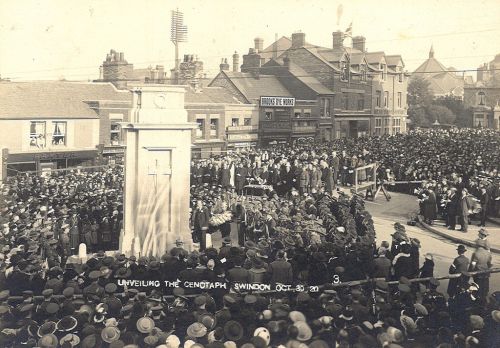 | ||
| The Swindon Cenotaph at its unveiling [Image: www.swindonhistory.blogspot.co.uk] and (below) as it is seen today | ||
The
names of those honoured were listed on a plaque inside the Town Hall
itself. The old Town Hall ceased to function as the town hall in 1938
when new premises were built elsewhere. The building has fulfilled many
functions over the years and was long in use as a reference library. It
now houses a dance studio on the ground floor. On enquiry at the
building as to what had happened to the war memorial plaque, the dance
studio personnel looked perplexed and said they had no idea. An
Internet search has however revealed that the plaque is still in its
original position in the old Town Hall, behind a curtain in the dance
studio! This means it is not readily accessible and not fulfilling its
purpose. Swindon War Memorial, languishing behind a curtain in a dance studio in the former town hall! Thanks to Jeremy Banning for permission to use the photo from his website www.jeremybanning.co.uk. |
|
Sanford Street School Memorial The school in Swindon attended by Horace Bradley has its own memorial, which bears the name 'Bradley, H.'. |
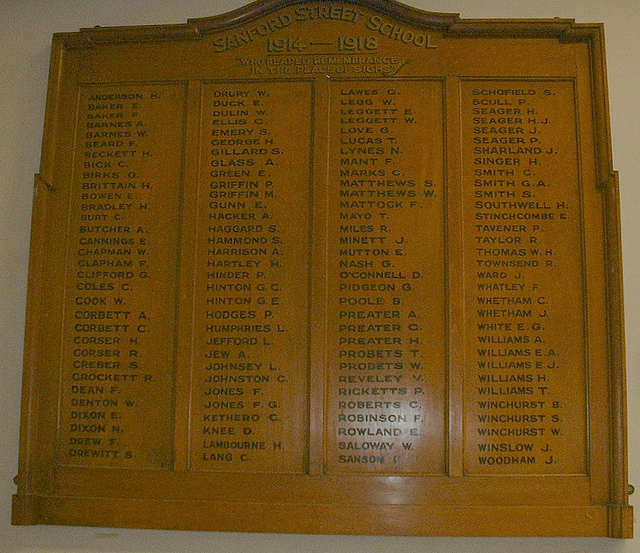 | ||
| [Image: www.swindonhistory.blogspot.co.uk] |
|
All Saints Church, Swindon Horace Bradley is also commemorated in the church which was local to his home in Ferndale Road in Swindon.
Thanks to James Turner of Swindon for providing us with this photograph. |
|
Berkhamstead Memorial |
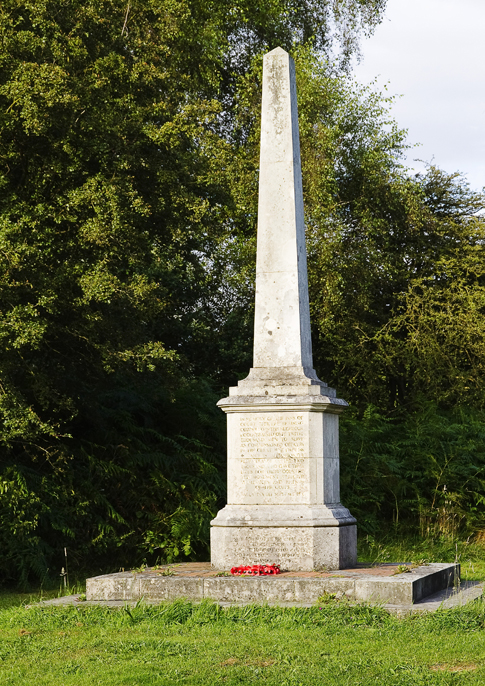 | ||
| The inscription: "In memory of the Inns of Court Officers Training Corps who in this neighbourhood trained over twelve thousand men to serve as commissioned officers in the Great War 1914-18 and in affectionate remembrance of the two thousand who gave their lives for their country, this monument is erected by members & friends of the Corps." |
Further Information |
Living RelativesThere are no living descendants of the small Bradley family unit. When parents Thomas and Ellen died in 1936 & 1939 respectively (with the address in both cases still 225 Ferndale Road, Swindon), they had already outlived all three of their children. With Kathleen having died in infancy and Horace killed in the war, the last surviving offspring was Helen, who married Sidney Snell in Swindon in the first quarter of 1929, but died in Birmingham later the same year. It would be great to hear from any other - even more distant - living relatives of Horace Bradley. Please get in touch!If you have any further information on Horace Bradley or want to suggest corrections / improvements for this page, please use the Contact page to get in touch. |